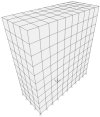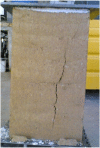First Exploratory Study on the Ageing of Rammed Earth Material
- PMID: 28787920
- PMCID: PMC5455227
- DOI: 10.3390/ma8010001
First Exploratory Study on the Ageing of Rammed Earth Material
Abstract
Rammed earth (RE) is attracting renewed interest throughout the world thanks to its "green" characteristics in the context of sustainable building. In this study, the ageing effects on RE material are studied on the walls which have been constructed and exposed for 22 years to natural weathering. First, mechanical characteristics of the "old" walls were determined by two approaches: in-situ dynamic measurements on the walls; laboratory tests on specimens which had been cut from the walls. Then, the walls' soil was recycled and reused for manufacturing of new specimens which represented the initial state. Comparison between the compressive strength, the Young modulus of the walls after 22 years on site and that of the initial state enables to assess the ageing of the studied walls.
Keywords: ageing; in-situ measurement; rammed earth; sustainable development.
Conflict of interest statement
The authors declare no conflict of interest.
Figures










References
-
- Bui Q.B., Morel J.C., Hans S., Meunier N. Compression behaviour of nonindustrial materials in civil engineering by three scale experiments: The case of rammed earth. Mater. Struct. 2009;42:1101–1116. doi: 10.1617/s11527-008-9446-y. - DOI
-
- Walker P., Keable R., Martin J., Maniatidis V. Rammed Earth-Design and Construction Guidelines. BRE Bookshop; Watford, UK: 2005.
-
- Habert G., Castillo E., Vincens E., Morel J.C. Power: A new paradigm for energy use in sustainable construction. Ecol. Indic. 2012;23:109–115. doi: 10.1016/j.ecolind.2012.03.016. - DOI
-
- Allinson D., Hall M. Hygrothermal analysis of a stabilised rammed earth test building in the UK. Energy Build. 2010;42:845–852. doi: 10.1016/j.enbuild.2009.12.005. - DOI
-
- Bui Q.B., Morel J.C., Reddy B.V.V., Ghayad W. Durability of rammed earth walls exposed for 20 years to natural weathering. Build. Environ. 2009;44:912–919. doi: 10.1016/j.buildenv.2008.07.001. - DOI
LinkOut - more resources
Full Text Sources
Other Literature Sources

